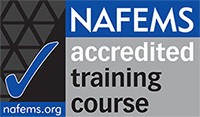What are Electromagnetic fields? How can we mathematically describe them in a clear and understandable way?
How can we compute Electromagnetic fields and critically assess the results?
What are boundary and initial conditions, and how do we set them prior to our simulation?
How can we effectively and accurately perform Electromagnetic simulation? What are the best-practice simulation tips and tricks?
Unlock the complexities of electromagnetic analysis and expand your analysis skillset to include advanced concepts with this cutting-edge e-learning class from NAFEMS.
Basic Electromagnetic FEA
This course will help you to understand basic electromagnetic equations, to master their solution using the Finite Element Method, and to properly interpret and use the results.
The course starts with fundamental topics such as electric field, magnetic field, electric scalar potential, and magnetic vector potential.
It then guides you through Partial Differential Equations (PDEs) of the introduced scalar and vector fields describing different electromagnetic problems of practical relevance, namely, electrostatics, magnetostatics, eddy current, displacement current, and wave propagation.
Finally, the course demonstrates the best modelling and simulation FEM practice through numerous practical examples.
At the end of the course, several advanced topics will be discussed such as field discontinuities and singularities, material nonlinearities, computational domain size, convergence studies, and CAD considerations.
Who should attend?
Designers and engineers who have some familiarity with electromagnetic analysis or those who are experts on some other simulations and are looking to extend their knowledge to electromagnetics.
What will you learn?
The main goals of this course are:
- to convey to designers and engineers the necessary theoretical background of electromagnetic simulations;
- to demonstrate an efficient path from the theory to practical simulation models;
- to train the participants to critically asses and properly use the obtained results; and
- to help the participants to gain confidence in their simulation models and their capability to understand and use EM field simulations in daily design.
The corner stones of the course are:
- Electromagnetic fields and their mathematical description (partial differential equations and boundary conditions).
- Finite Element Method for electromagnetics in 1-D, 2-D, and 3-D.
- Practical applications (electrostatics, magnetostatics, eddy currents, displacement currents, and Electromagnetic wave propagation).
- Advanced concepts (field discontinuities and singularities, material nonlinearities, air box size, convergence studies, and CAD considerations).
The background to each topic is presented and a set of practical hints and tips is provided. The methodologies used to set up the analyses and to understand the implications of the results are fully explored.
The examples provided are solved using the tutor’s own programs, which were developed in Matlab. All the programs (1-D, 2-D, and 3-D FEM) are provided and explained to the participants and could be used and further developed afterwards for non-commercial purposes free of charge.
Why an e-learning class?
Travel and training budgets are always tight! The e-Learning course has been developed to help you meet your training needs.
If your company has a group of engineers, or specific training requirements across any subjects, please contact us to discuss options.
Course Program
This is a four-week live web-based eLearning course with a total of 10 teaching hours of tuition (presented in a 2.5-hour session each week).
Session 1
Fundamentals of Electromagnetic Field Theory
Integral forms, diff. equations, fields, potentials, interface conditions, etc.
Session 2
Finite Element Method for electromagnetics in 1-D, 2-D and 3-D
Element types, boundary conditions, sources, accuracy, etc.
Session 3
Applications: electrostatics, magnetostatics, eddy currents, displacement currents, EM wave propagation, etc.
Session 4
Advanced concepts: field discontinuities and singularities, material nonlinearities, air box size, convergence studies, and CAD considerations.
Feedback from former e-Learning students:
"Super! Doesn't get better than this. Good idea to start having e-Learning courses."
R.P.
"I'm really happy not to pay a big fraction of my annual training budget to airlines and hotels. A BIG plus to e-learning."
V.G.






